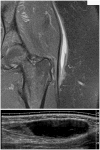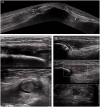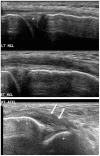Ultrasound of lower limb sports injuries
- PMID: 27433251
- PMCID: PMC4760585
- DOI: 10.1177/1742271X15588809
Ultrasound of lower limb sports injuries
Abstract
Musculoskeletal ultrasound utilises high-frequency linear transducers to produce high-resolution images of soft tissue structures. It is an increasingly useful tool in the assessment of both acute and chronic musculoskeletal injuries; it is relatively cheap, portable and can be used to facilitate targeted injections. In this review paper, we aim to provide a summary on the normal and abnormal appearances of skeletal tissue in the setting of acute and chronic lower limb sporting injuries.
Keywords: Ultrasound; injuries; lower limb; sports.
Figures






Similar articles
-
A one-stop approach to the management of soft tissue and degenerative musculoskeletal conditions using clinic-based ultrasonography.Musculoskeletal Care. 2011 Jun;9(2):63-8. doi: 10.1002/msc.194. Epub 2010 Nov 2. Musculoskeletal Care. 2011. PMID: 21618397
-
Musculoskeletal Simulation Tools for Understanding Mechanisms of Lower-Limb Sports Injuries.Curr Sports Med Rep. 2019 Jun;18(6):210-216. doi: 10.1249/JSR.0000000000000601. Curr Sports Med Rep. 2019. PMID: 31385836 Review.
-
The application of musculoskeletal ultrasonography in sports injuries of lower limbs in Chongqing Marathon competition.J Sports Med Phys Fitness. 2020 Jan;60(1):102-109. doi: 10.23736/S0022-4707.19.09925-0. Epub 2019 Dec 5. J Sports Med Phys Fitness. 2020. PMID: 31818053
-
Gender-related differences in lower limb alignment, range of joint motion, and the incidence of sports injuries in Japanese university athletes.J Phys Ther Sci. 2017 Jan;29(1):12-15. doi: 10.1589/jpts.29.12. Epub 2017 Jan 30. J Phys Ther Sci. 2017. PMID: 28210029 Free PMC article.
-
Introduction to diagnostic musculoskeletal ultrasound: part 2: examination of the lower limb.Am J Phys Med Rehabil. 2008 Mar;87(3):238-48. doi: 10.1097/PHM.0b013e31816198c2. Am J Phys Med Rehabil. 2008. PMID: 18174843 Review.
Cited by
-
Intra-session and inter-rater reliability of spatial frequency analysis methods in skeletal muscle.PLoS One. 2020 Jul 10;15(7):e0235924. doi: 10.1371/journal.pone.0235924. eCollection 2020. PLoS One. 2020. PMID: 32649705 Free PMC article.
-
The popliteofibular ligament: a cadaveric ultrasound study.Skeletal Radiol. 2022 Jan;51(1):183-189. doi: 10.1007/s00256-021-03813-9. Epub 2021 Jun 19. Skeletal Radiol. 2022. PMID: 34146118 Free PMC article.
-
Ultrasound Imaging in Diagnosis and Management of Lower Limb Injuries: A Comprehensive Review.Med Sci Monit. 2024 Sep 3;30:e945413. doi: 10.12659/MSM.945413. Med Sci Monit. 2024. PMID: 39223775 Free PMC article. Review.
-
Use of Reflective Tape to Detect Ultrasound Transducer Movement: A Validation Study.Life (Basel). 2021 Jan 30;11(2):104. doi: 10.3390/life11020104. Life (Basel). 2021. PMID: 33573159 Free PMC article.
References
-
- Weatherall PT, Crues JV. Musculotendinous injury. Magn Reson Imaging Clin N Am 1995; 3: 753–72. - PubMed
-
- Torriani M, Kattapuram SV. Musculoskeletal ultrasound: an alternative imaging modality for sports-related injuries. Top Magn Reson Imaging 2003; 14: 103–111. - PubMed
-
- Erickson SJ. Sonography of the foot and ankle. Foot Ankle Clin 2000; 5: 29–48 (v). - PubMed
Publication types
LinkOut - more resources
Full Text Sources
